OPEN Cycles is an interesting company. Founded in 2012 by two heavyweights in the cycling industry, Gerard Vroomen and Andy Kessler, it feels like a passion project that they both take very seriously. Gerard co-founded Cervelo with Phil White in 1995, and if you’ve heard of a bike company called BMC, that’s because Andy transformed it during his tenure as CEO, expanding its racing presence to turn them into a prestigious household name in cycling.
Between the two of them, their brands have hoovered up just about every award, accolade, and victory cycling has to offer. OPEN has been no less formative and structural to the industry. Perhaps more than any other single bike, the OPEN U.P. (Unbeaten Path) defined and stabilised the nascent gravel scene when it emerged about a decade ago. It introduced the world to dropped chainstays, perhaps the most copied workaround solution to fitting wide tires into road-bike geometries, components, and chainlines.
Consequently, OPEN punches seismically above its weight class; they’re a fraction of the size of the big brands in the industry, but the company’s agility and rider-centric innovation make them a serious presence at the forefront of bike design. And it’s this facet of their relative size that means they don’t update their bikes every 18 months. Consequently, their designs need to look proleptically forward in time, to predict and cater to the cycling landscape and consumer tastes, both now and for years to come. And such is their success at this, that the original U.P. released in 2015, with a few revisions in 2019, is still in the OPEN range.
So when Gerard and Andy announced a new bike, the first in a whole slate of new bikes, I craned in to see what their prophet-like clairvoyance would predict for the future.
A new CONCE.PT – A new OPEN UP(PER)
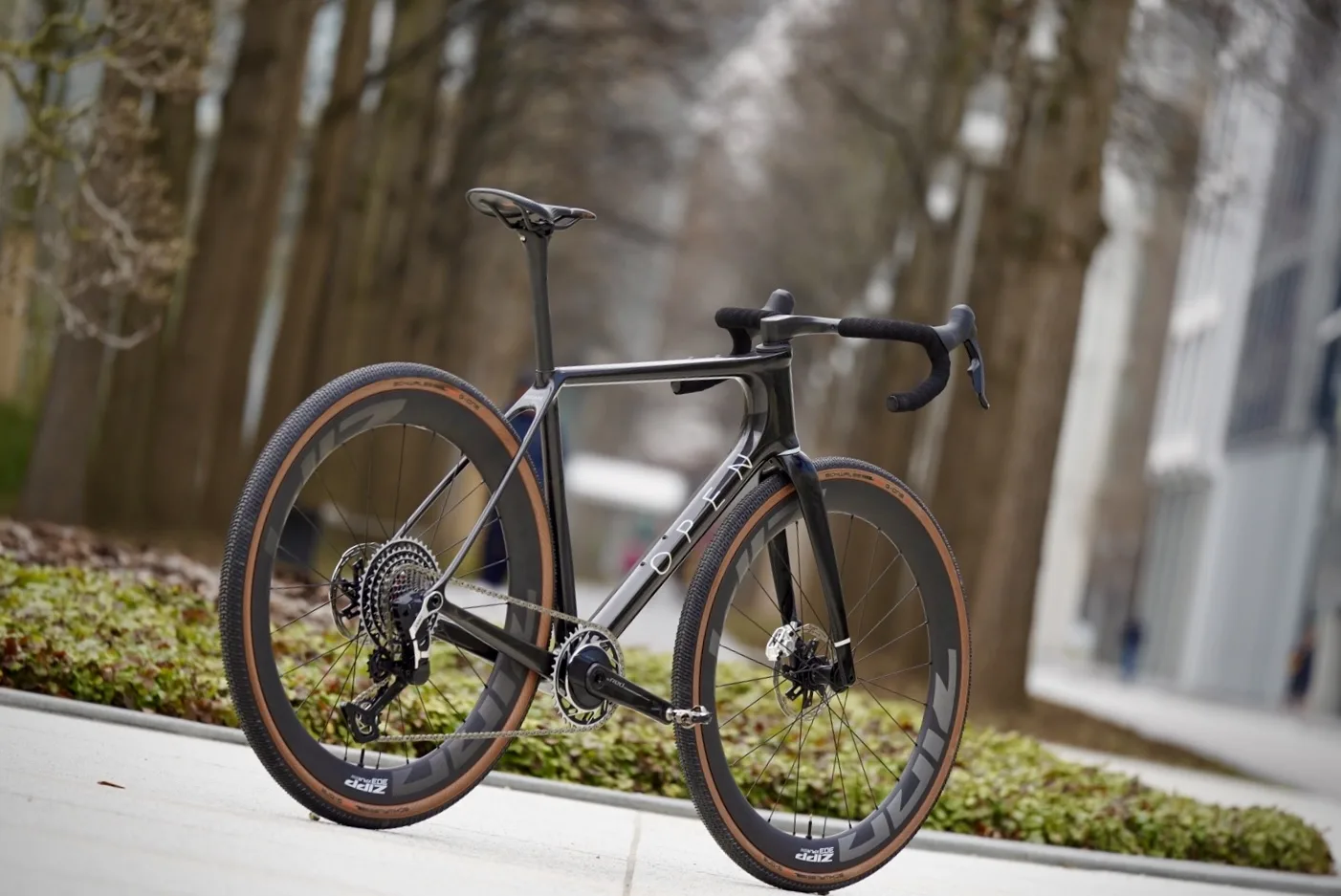
The first bike to break cover, the U.P.PER. CONCE.PT, other than being a nightmare of punctuation and capital letters, is also part statement of intent, part proof of concept, and part showing off.
It’s an “U.P.PER.,” so a premium lightweight version of the U.P. (New ‘regular’ UPs and UPPERs are to come this year,) but the ‘concept’ moniker here delineates it as a prestige issue, limited in number to just 125 units in only 2 sizes (a medium and a large).
With the ‘PT’ signifying their new partnership with Carbon Team, a specialist high-tech carbon works based in Portugal. (PT also conveniently being nomenclature for ‘Prototype’ in design circles). This radical move to ‘onshore’ the production process, so that 100% of the bike is produced ‘in freedom’ as Gerard says, massively increases their costs. It also serves as a litmus test of the company’s ethical credentials.
Even though I ride and test many bikes, it’s been nearly 7 years since I bought myself a new one. I broke that streak when they announced this concept bike and placed my order with high expectations.
I sat down to talk to Andy and Gerard about the next few years of drop-bar cycling as they saw it, and how this new concept bike manifests their vision. Here’s what they had to say…
Interview with Gerard Vroomen & Andy Kessler
We spoke on the 26th of March, 2025, nearly 6 months after the bike was announced, and a couple of weeks before the first frames were being dispatched. I asked if 6 months from announcement to shipping was normal, and the reply came back promptly:
“No, and I hope it never becomes the standard either,” said Gerard. “I mean, this is the good and the bad bit of having a company where you can do whatever you want. The good thing is that there’s no pressure for us in the sense that if we launch and then we come across something that we want to still improve a bit, then we can. But of course, it makes it sometimes hard to get the cutoff and really start shipping. So it’s been a frustrating six months, that’s for sure. But I think, you know, that the end result is better for it.”
There’s an old expression about not letting the ‘perfect be the enemy of good,’ which is immediately called to mind. But the idea of bike designers being perfectionists, I have to say, I’m really here for. If you’re going to be hurtling over some pretty sketchy terrain at high speeds on one of their products, I suspect you’re going to value this mindset.
“How much of this do you think is due to the fact that you guys have brought production back to Europe, to Portugal?” I asked. OPEN has partnered with Carbon Team, a high-tech carbon manufacturing firm launched by investors from Portugal, Germany, and Taiwan in 2018.
“No, the buck stops with us,” says Gerard. “It has nothing to do with our suppliers in that sense… they’re very responsive [we] get a lot of attention and you can talk directly to the people who make things happen. So, no, I think the collaboration with Carbon Team is very good and yeah, we’re looking forward to many years to come.”
No More 650b
One of the first things I noticed when I pored over the specifications of their new bike was that support for 650b wheels had disappeared. The once darling of the gravel world, the industry’s love affair with it seems to have lasted just one generation, and very few people are building in 650b compliance or making any noise about it. What’s happened there?
“I certainly have not fallen out of love with 650b, I love 650b.’ said Gerard. “I think it is in many cases, the right choice. But the audience has fallen out of love with 650b. And there’s no point building them if people aren’t buying them, right? At some point, the warehouse is full, and then you have to stop. The reality is that consumers, even those who would be better off in 650b, prefer to ride 700c. And I think we’ve done all we could to educate people where 650b makes sense. Certainly, there’s a group of people who still appreciate that, but that group has become very, very small.”
This seems to be despite OPEN’s best efforts.
As consumer’s we’re often frustrated with brands, feeling as if we’re being corralled into endless subscription models, and yet another standard, particularly in cycling. So it was certainly surprising to hear this was a battle the industry had sort of fought and lost. People really had voted with their feet and wallets.
Dropped Chainstays are Dropped
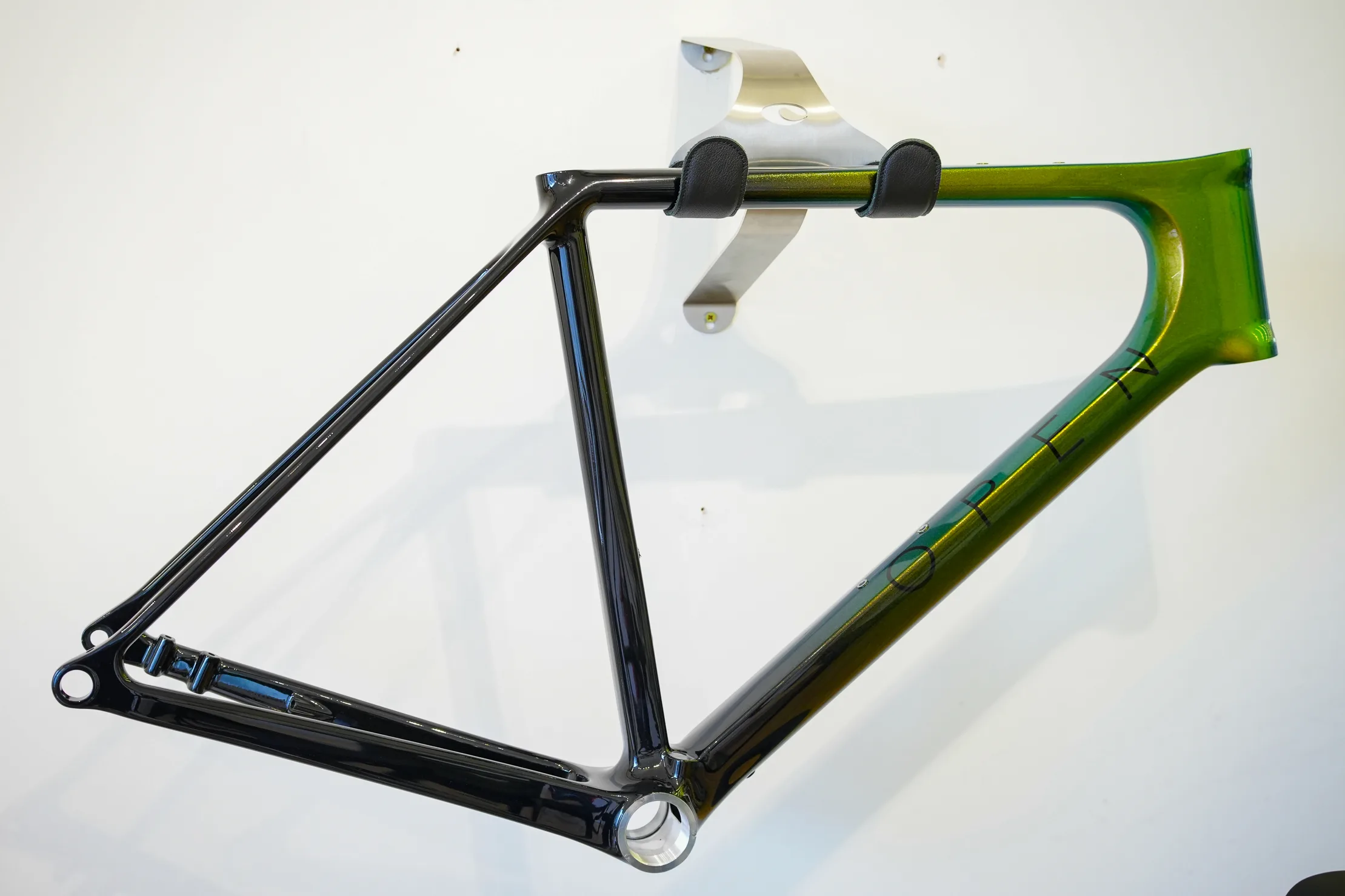
Aesthetically as I look at the bike, I have to say I think it’s a beauty, which of course is in the eye of the beholder, but the OPEN’s lines are somewhere between classic and modern: They’ve chosen not to drop the seatstays, retaining the characteristic cycle triangles. But the aero touches, the very deep yet narrow headtube, and the front-end shaping are thoroughly cutting edge.
It also still looks like an OPEN.
The tube shapes, and bowed seatstays (though for this generation, they’ve been rotated 90 degrees, so they bow laterally for flexibility rather than vertically) are distinct and unmistakably OPEN. Perhaps more importantly, this new bike is absent of perhaps the biggest and most copied feature of its predecessor – the dropped chain-stay.
“The dropped chainstay that we introduced on the UP sort of [became] the telltale of a gravel bike, if it has a drop chainstay, it must be a gravel bike,” says Gerard. “But we didn’t drop the chainstay because we liked the curve or anything like that. It’s to achieve something, to achieve a certain tire clearance. And so now, as we go to our new range of bikes, we’re trying to segment a little more between the U.P. and the WI.DE. and the MIN.D. So while there’s reasonable overlap between [them, we are trying to] make the differences bigger. And so the UP / UPPER category is becoming a really fast, racy type of frame, with very good tire clearance. But with modern technology and matching modern cranks, we can do it with straight chainstays.“
“You have to remember, when the original UP was launched, there weren’t really any gravel groupsets. So you were riding with a road groupset with a very narrow chainline. And if the chainline’s narrow, the chainring is closer to the center, so there’s not as much space between the tire and the chainring to put the chainstay through. Now, even road cranks have gotten a little wider. And of course, gravel cranks are even wider still. So the chainrings have moved out, and there’s more space between the chainring and the tire to put a chainstay through; you don’t need to curve as much to get around all this stuff. It’s just gotten less crowded at the bottom bracket.”
Pick Your Dropbar Bike by Tire Clearance and Go

Gerard’s answer here revealed a number of interesting trends: Firstly, that the industry has embraced the gravel sector, and is finally designing accordingly. It’s great to look and see where it started, as an offshoot of road, hamstrung by the limitations of the componentry and forcing designers to find workarounds. Now fully in bloom, the gravel sector tech has caught up and standardised, putting dropped chainstays out of requirement.
Perhaps even more interesting, though, is how OPEN sees the future of dropped bar bike design. They’re pushing the continuum wider.
They’re not using words and names to define the usage. There’s no ‘all-road’ or other nomenclature in their thinking. You don’t pick a bike according to category. You sort of just choose your tire width. And there’s of course overlap, but categorisation isn’t (really) in their thinking. To illustrate this further, Gerard confessed to using his MIN.D (traditionally thought of as a road bike) for light gravel duties.
With the new range of U.P./U.P.PER, WI.DE. & MIN.D to come, there’s a unifying brand philosophy: You’ll pick a bike based on tire clearance rather than anything else. And that will be determined by your preference and use, rather than picking a bike by category or label.
1x and Electronic Only
What else can we learn about the state of the industry to come?
This concept bike is 1x only… is that exclusively, is 2x dead?
“No,” came the answer from Gerard. “We will make 2x versions as well at some point.”
It’s important to note that the Concept bike is electronic only, too, which I’m fine with. The joys of SRAM 1x XPLR have made going back to anything else for me, somewhere between unnecessary and undesirable… However, I understand my position may not be everyone else’s… So I wonder if this could be the end for mechanical drivetrains at OPEN?
“I think our customer is just an electronic customer now,” says Gerard. “We can see on our website a lot of our customers upload their builds. We can see how people build their bikes, and they’re overwhelmingly electronic. And every year you move into the future, it becomes more so. As electronic groupsets go down in price, I mean, you look at SRAM particularly, they have four levels of electronic groupsets. None of our customers are looking for the fifth level from the top, you know, to a mechanical bike.”
Well, when you put it like that…
Suspension Incorrected
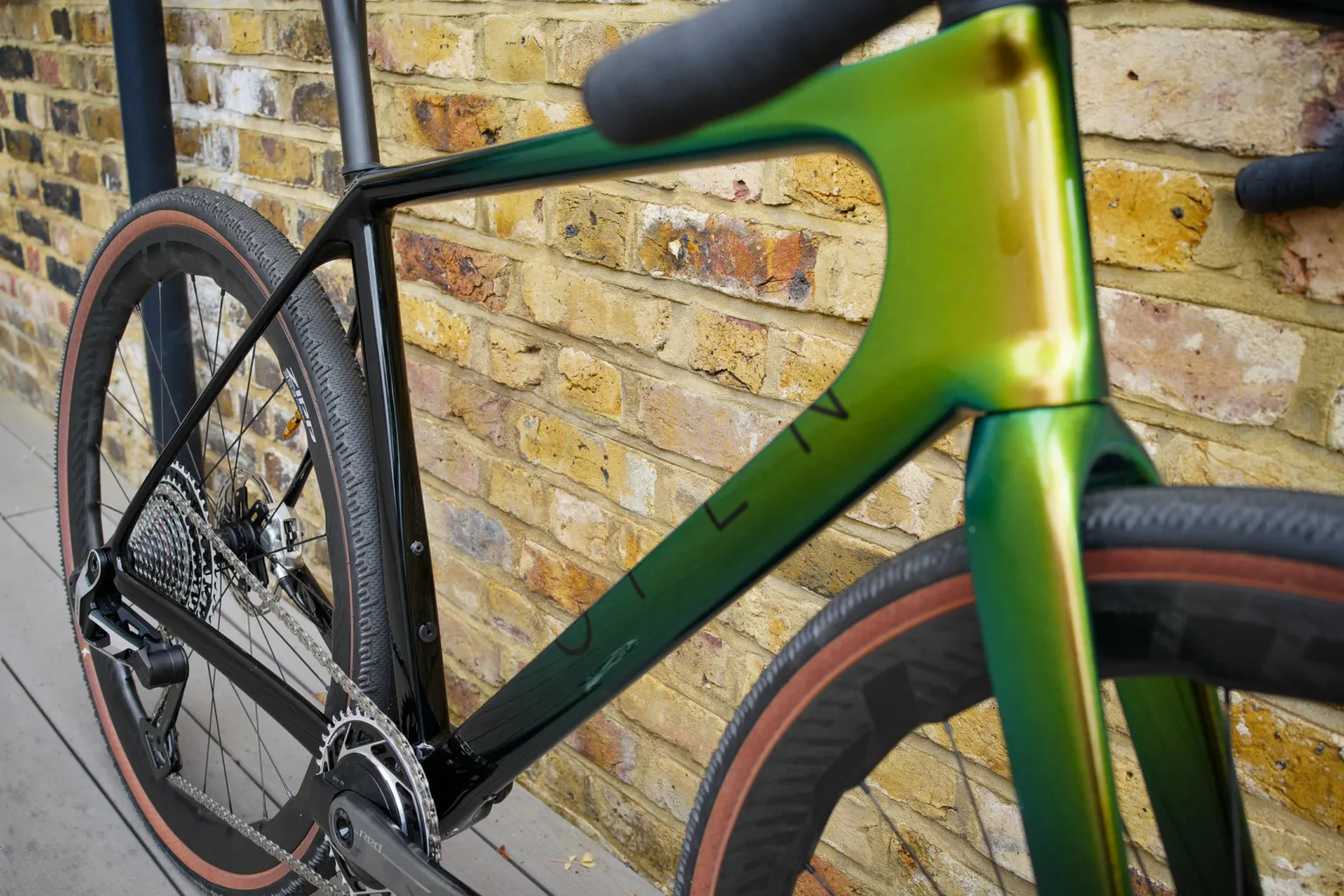
What about suspension? Do you see suspension coming to gravel or sort of darting around the edges for a while? Is this a suspension-corrected frame?
“We have nothing against suspension for the right application,” said Gerard, “but for this bike, it wouldn’t make any sense. The suspension that you need on this bike, you get from the tires. And it has the tire clearance to put big enough tires on to make that happen (700c x 44mm max on the U.P.PER). And so it is extremely suspension incorrect.”
To preview the next few years of gravel (by consumer standards), he added:
“I think for most people, what has made gravel so popular as opposed to mountain bikes, is that, that first 10 miles or 15 kilometers are asphalt roads because that’s sort of where you live. Most people live in cities. And so you need to get to the trails, and nobody wants to do those 10 miles on a slow mountain bike. That the gravel bike is fast and efficient is just so important, and suspension sort of plays against that. And then the other point is that also the people who make suspension products for gravel will tell you their products aren’t really that great yet, because it is extremely difficult to make a suspension fork for gravel. You have very little travel, and people are much more concerned about the weight.“
“So now what you have is [with a gravel suspension fork], if the bumps are big, the travel isn’t big enough. And if they’re washboards, the fork doesn’t react quickly enough. You’re hauling an extra kilogram of bike along with you, and there aren’t really that many situations where the terrain is really doing that fork a favor. So… maybe in the future, with different technologies and people working to improve these things, for sure that can change. The first mountain bike fork wasn’t that great either. But it’s much harder to make a good gravel fork than a good mountain bike fork.”
I guess this was exactly the way I felt about suspension on a gravel bike, personally. Although it had never been distilled to ‘falling between two stools’ in my mind, it was just about the weight/benefit trade-off being unbalanced currently.
Very Light, but Weight Wasn’t the Main Focus
But weight is certainly a factor, a big one to roadies, and not inconsequential to mountain bikers. This new Concept frame came out at 845 grams (size M, ready for paint without removable metal hardware).
So, was low weight a benchmark they chased? The 3T Extrema Italia that we tested, for example, comes out at a hair under 1100 grams for the same size and roughly the same cost. So, how important a factor was getting this to be a lightweight bike to OPEN?
“No factor at all, really,” says Gerard. “I mean, we never really focus on the weight. We want to achieve a lot of things, how the bike handles, and so the stiffness, and of course, the strength that you need in the frame. And then the weight is the result that comes out.“
OPENing Components Too

This new wave of bikes marks OPEN’s first foray into making components. Each bike ships with an OPEN (round 27.2mm!) seatpost and a proprietary fork and cockpit that are made for one another. Like all cyclists, I despair when another new ‘standard’ is posited. And ‘proprietary’ components are rarely worth the faff.
But then Andy and Gerard explained why they’d created a proprietary cockpit. And it seemed to solve a problem that came out of a genuine need. Whether you see it as solving a consumer need (for a greater number of cockpit sizes) or a small business problem (of not wanting too many SKUs), it seems to be a win/win. There are massive upsides to being a comparatively small and agile company (the ability to move quickly, change fast, less red tape, etc), but downsides too. This solution harnessed both to create a really novel product that I hope is adopted.
Perhaps we can look forward to OPEN becoming a component manufacturer?
“It’s not a primary goal,” said Andy Kessler, “but obviously this could happen. We’d like to work with some [brands] that share our technology.”
As a small brand, Andy decried the need to keep a large number of SKUs in stock to give each rider their stem length/handlebar width combination of choice. (With comparatively small numbers of cockpits sold compared to say, Trek, they don’t want to manufacture cockpits in 6 different stem lengths and 4 different widths. You’d need to make 24 different cockpit moulds, and then make them in expensively small batches, just to allow customers to choose their perfect permutation).
Smart Adjustable Length One-Piece Handlebar/Stem
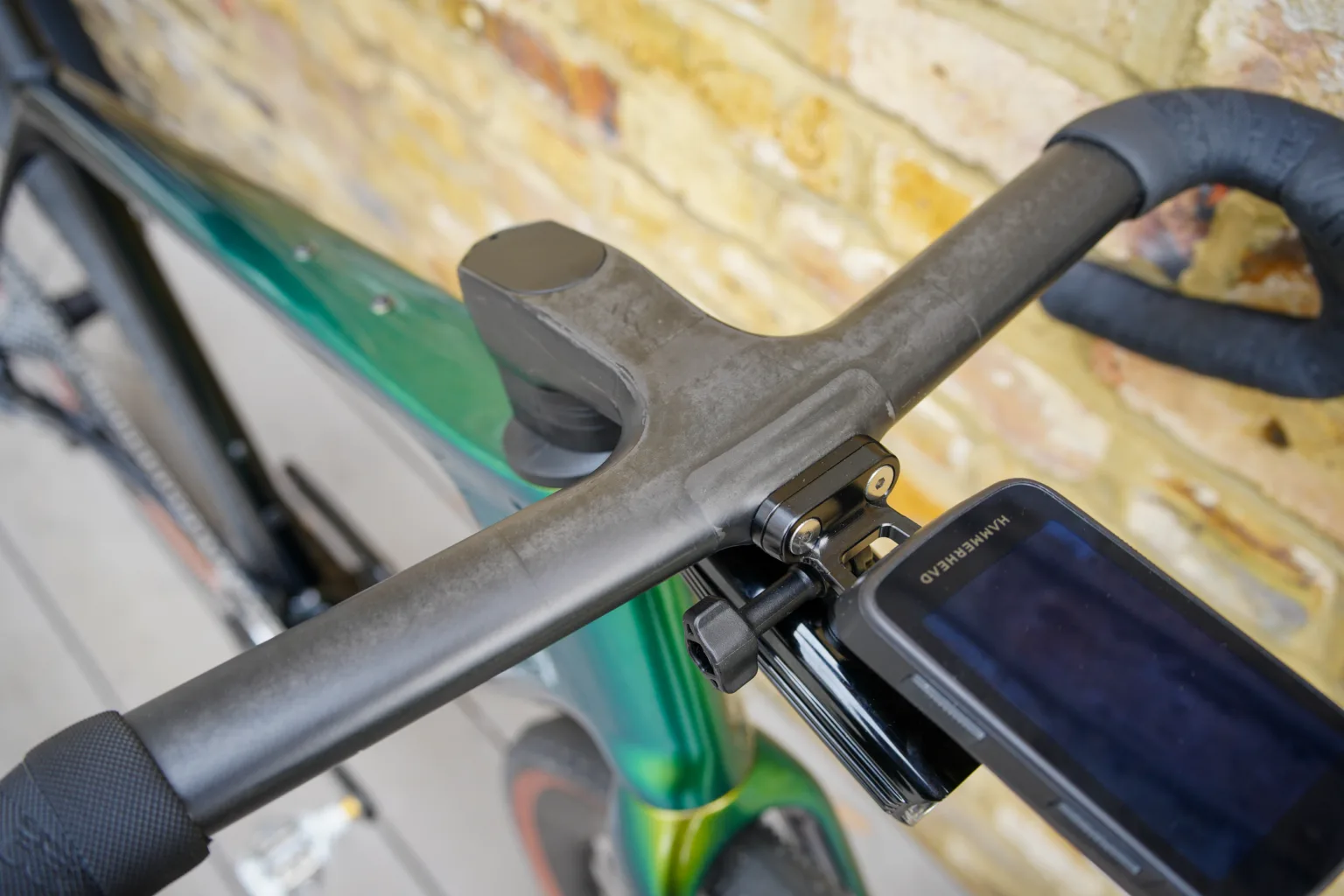

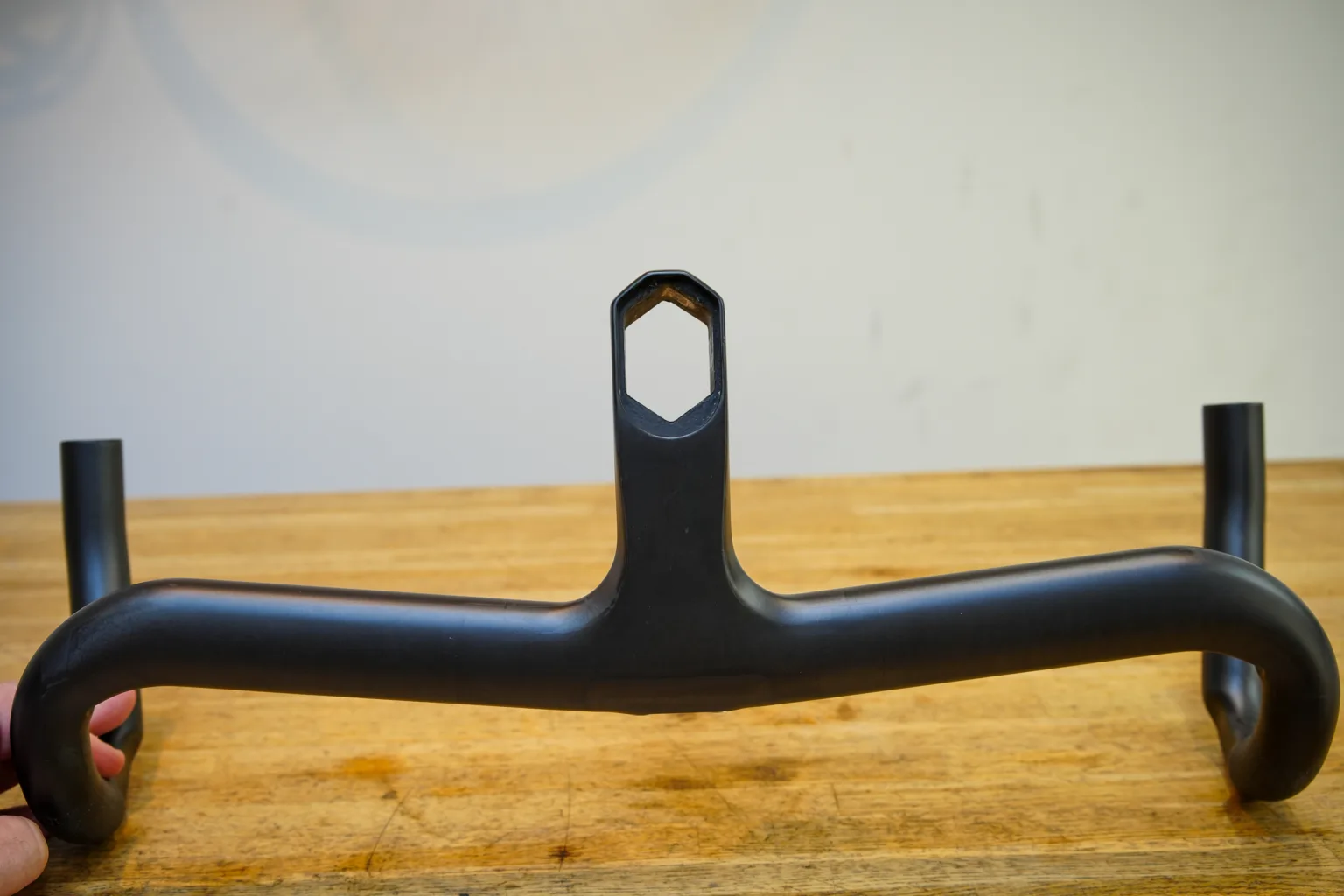


So, they came up with a pretty ingenious solution: an adjustable one-piece bar and stem, giving 15mm of length adjustment (in 5mm increments). So they have 11 SKUs for the cockpit, rather than 44.
“And no, we don’t want to become Easton or Ritchey” says Andy, “but yes, it would be cool if there are two or three small (perhaps) titanium brands that adapt our system and make cool bikes.”
That would certainly help with the economics.
To make it work, the steerer tube transitions from round at the fork crown to a sort of diamond shape, with two rounded corners. This allows it to be clamped inside the stem via bungs and clamps, and inserts that grip it. This probably gives a very solid purchase on the steerer tube, and also allows the stem the 15mm fore/aft adjustment.
It’s a creative design. But the fork, cockpit, and headset assembly are all proprietary. And so these components aren’t interchangeable with other brands. So when Andy says he welcomes other brands using their technology, it would have to be all three parts, or at least license their tech, if not just using their components directly.
European Production

Speaking of such things, it would have been fair to say that 4 weeks ago, at the time of this interview, you could have called it a challenging time in the bike industry, to move production from the cheaper Asian suppliers to the more expensive European producers. Yet, if you’re in America reading this, the events of the last few weeks since our interview have made buying a European-produced bike potentially cheaper than buying one produced in China, depending on how the ever-changing new tariffs take effect. However, none of this was visible at the project’s start or even our interview. Without this foresight, I was curious what possessed Andy and Gerard to make the move to dramatically increase their production costs at a time when the whole cycling industry was hurting.
Why now?
“Well, it’s not really now,” said Gerard, “we didn’t decide yesterday to produce in Portugal. When we made that decision, the bike industry was a lot different than it is today. Why now? We looked a couple of years ago at this world and thought, you know, this world isn’t getting any nicer. We’re lucky that we live in countries that are relatively well organized, we get the vote, and those are fairly honest votes. And we get to ride our bikes. And especially gravel bikes to us, [are] really the ultimate sensation of freedom. And we thought, you see things in the world you don’t like, you can’t necessarily make any real influence on it. But the small influence we have is that we own a company. So we can put not only our own dollars, but also the company’s dollars, where we believe in it.“
“And so that’s why we decided that, if we ride ‘in freedom’, we also want to produce these bikes ‘in freedom’. And so that was really the main reason to reshore. I’ve always liked producing close to where the bikes are dreamt up and where the bikes are used. I wanted to do this 30 years ago with Cervélo. The only places you could really produce carbon at some volume was in Asia. So that all went offshore. But at Cervélo, we always said if we could produce locally for double the price, we would.“
“And of course, we [at Cervélo] had Project California, where we set up some production in California, which was definitely not double the price, but more like 10 times the price. And at 3T, we brought production back to Italy. So I’ve always been interested in it, and we were pretty good friends with the Bike Ahead people in Germany, who were one of the founders of the Carbon Team project in Portugal. So that sort of made us think, here’s a factory where we can make very nice, technically very good bikes, stiff, strong, and light. This is the place where we can do this. And hopefully for a relatively reasonable price.”
There’s a lot to love about this sentiment, and it’s wonderfully gratifying to see a company putting their dollars where their mouth is. So let’s get to the nitty gritty.
What’s the price difference?
“For the unpainted frames, the cost is a bit more than double,” said Gerard. “The painting is a real killer because it’s very labor-intensive. Carbon costs the same in Europe and in Asia, so labor is really the difference, and painting is a relatively labor-intensive process. Actually, in Europe, they can put less labor in. If you put a lot more focus on quality at the start, then you have less sanding and you have less finishing, and all these things add up at the end. So you can save some labor. Painting is painting. It’s just a lot of labor.“
“So when you look at the painted frames, it’s closer to 3x, but on unpainted frames, it’s 2x. And we do a lot of unpainted frames because a lot of our customers want to do custom paint.”
About 30% of OPEN frames are sold ready-to-paint and go off to a custom painter. As someone who was about to embark on my own custom paint journey (a thoroughly brilliant and rewarding process if you have the budget), I had found myself slowed by chronic indecision. Gerard clearly felt my pain, or conveyed that I was not alone… “This is the problem,” he said, “That’s why I say only offer one color. If you offer two, people want the third.”
He’s not wrong.
The Future of Gravel?
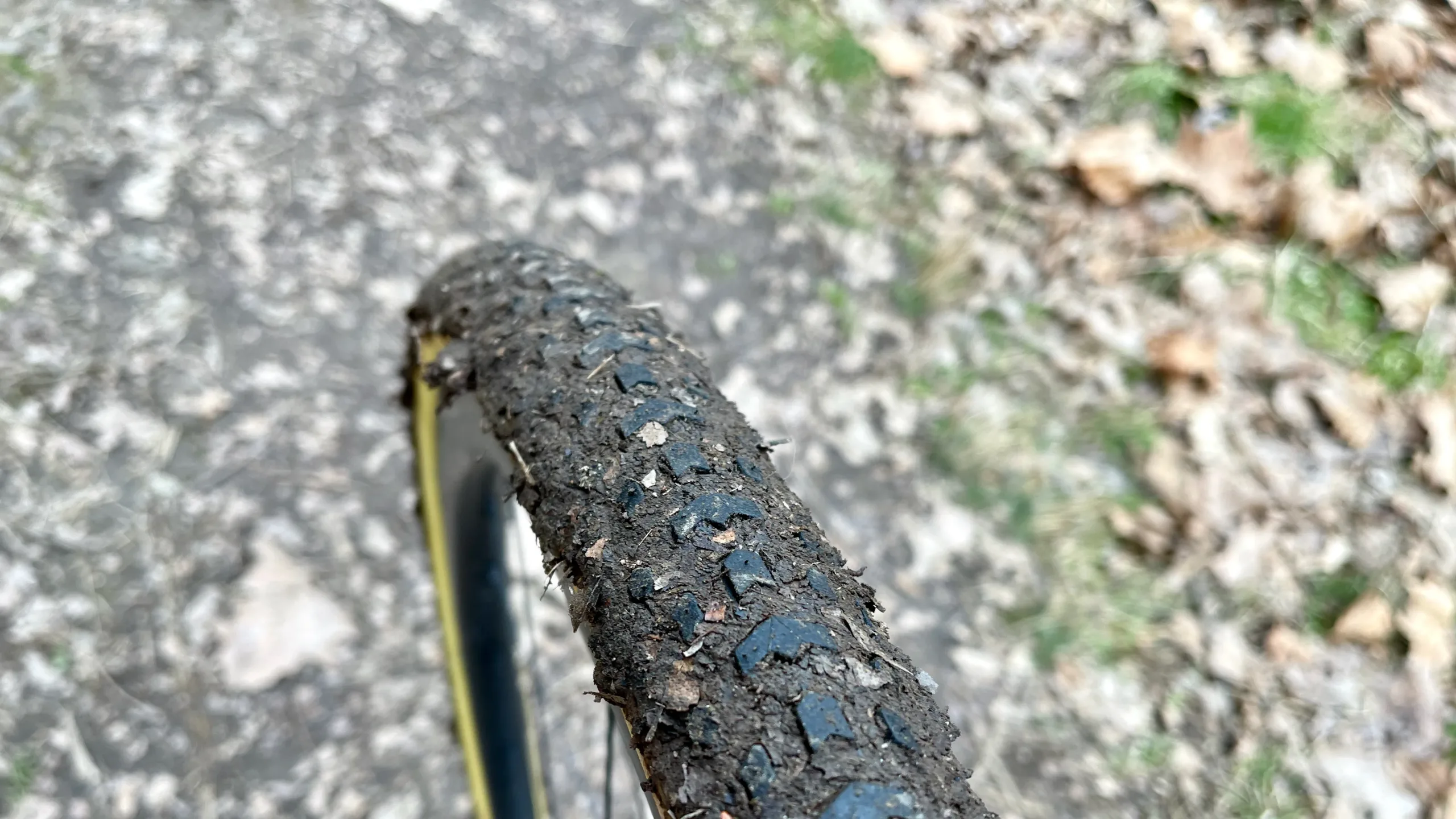
Going back to the future of Gravel and OPEN, and the lack of labels, I asked Andy to expand more on this. On a spectrum, you choose your bike by tire size rather than anything else?
“Yeah, gravel is a very wide term,” he said, “so it’s basically like every category. We had the discussion before, you know, do you want to have suspension forks? And I’m always a fan of the 80-20 rule, which is, it has to be a bike [that’s great] for 80% of what you do, and feels better then, than the other 20%. And so I think talking about ‘gravel bikes’ is basically wrong because [they’re] so much more. [They’re] bikes you can do almost everything on. If I could only have two bikes, it would be a gravel bike, and then it would be a mountain bike with 150mm plus suspension. It makes more sense going forward that we talk about tire clearance, because a lot of people use the MIN.D (their ‘road’ bike) for gravel. I know Gerard does for sure.”
At this point, Gerard nodded confirmation. It doesn’t get more from the horse’s mouth than this. I guess if you don’t need huge clearance, and you’re riding light gravel terrain, the founder and designer of OPEN bikes has confidence and preference for his ‘Road’ bike. I notice I’m trying and immediately failing to do away with labels. So you move up a bike as demanded by the terrain and the tire clearance. Every bike’s a gravel bike if the gravel’s gentle enough?
“So I think going forward, I think it makes much more sense that you talk about tire clearance because, there’s a road bike that you can go off-road, or there’s an off-road bike that you can use on the road,” continues Andy. “That’s also why I think in the future we will have a bigger segmentation between the UPPER and the WIDE.“
“Maybe Gerard just can’t get hold of a gravel bike,” I joke.
“I’ve been asking Andy for a discount and he just won’t give me one!” comes Gerard’s swift reply.
Change Your Tires… or Don’t

Either way, clearly the MIN.D has clearance for Dutch gravel.
“In the Netherlands, the gravel isn’t very difficult. And you’re riding on a lot of asphalt roads to connect your gravel pieces… but also, good gravel tires are just really fast. I have a friend who visits me every year from Canada, and this year we did four days of real gravel riding, and then we did the Amstel Gold touring ride, and he does just everything on the gravel bike, and he doesn’t even change the tires. He’s going to [ride] 240 kilometers on his gravel tires on asphalt.”
As I strategize my own build of this bike, this thought has occurred to me, too. The new raft of gravel tubeless tires is slick enough and fast enough for the road, and wide and grippy enough for gravel. The most overused phrase in cycling used to be ‘Quiver killer’, or ‘N+1 killer’… something that communicates a single bike to do it all.
Thankfully, the incidence of its usage seems to be in decline, but it’s the triteness of the phrase rather than the sentiment I object to. The concept is absolutely valid for most people who don’t have piles of bikes, especially not at this price point. And I’d rather have one bike I adore, rather than two for the same price, I’m ambivalent about. As Andy said, he could survive with only two bikes. Big quivers are becoming less necessary, and that’s because gravel tech is simultaneously helping bikes become better gravel bikes AND better road bikes. Again, failing to stop using the terminology. The same is true of wheels, I ended up pairing Zipp’s 25mm internal 353 NSW wheels with Schwalbe’s G-One RS Pro tires for a sublimely plush setup that’s equally as happy screaming along tarmac as being thrown down almost any gravel here in the UK.
“You should just spend your time riding,” says Gerard, “not changing wheels and tires, just go out and ride… That’s really that spirit of freedom. And Andy also [says] to me, the most fun in riding is just riding on a bike that’s always fast, and then no matter what you come across, go ‘yeah, let’s ride here. See where it leads.”
What About the Previous Models?
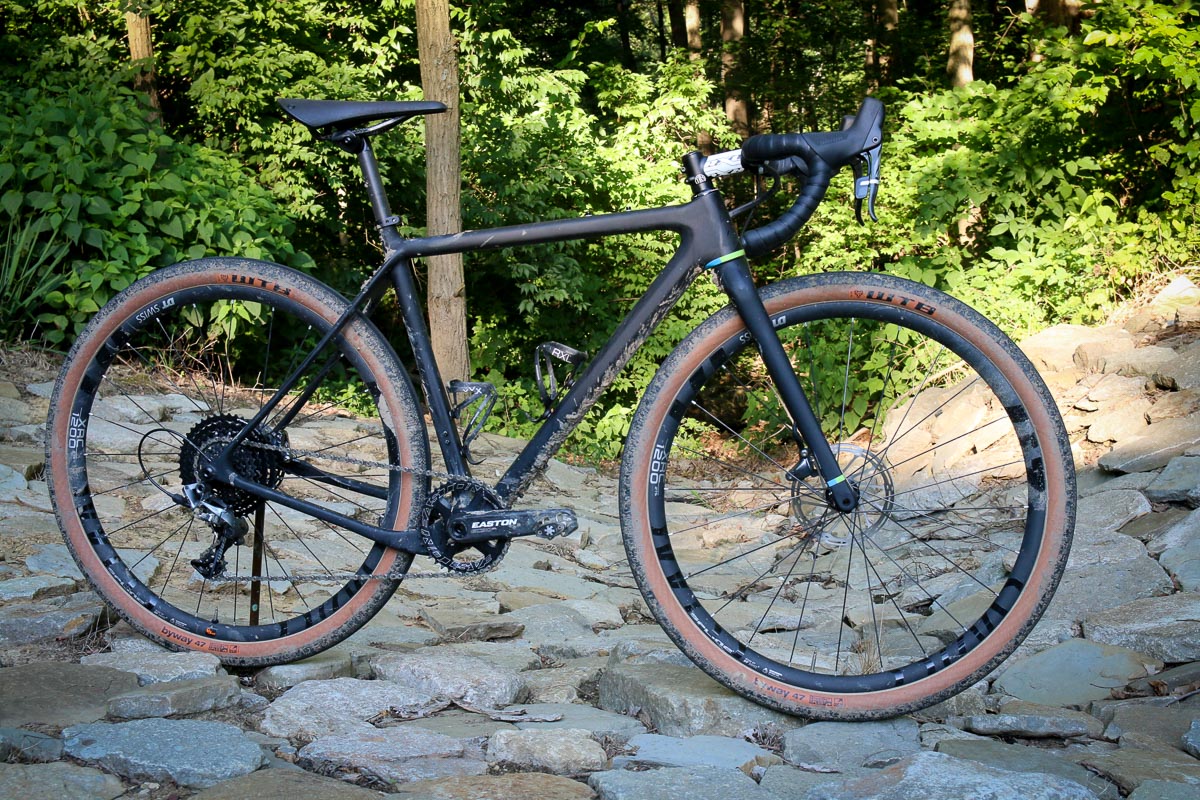
With the advent of OPEN’s new European-produced frames, I wonder what will happen to their lineup of Asian produced frames.
“So the made-in-Asia frames, sooner or later, we’re going to fade them out. But for this year, they will stay in the lineup.”
Well, what about the next year or so of releases for OPEN, we know that the U.P. / U.P.PER. will be next (the U.P.PER. Concept is a stripped-back version of those, so broadly similar), and then presumably we’ll get new versions of the WI.DE. and MIN.D.?
“The WI.DE. will just move a little bit away from the U.P. and U.P.PER., and the MIN.D sort of stays more in its place. But as happened with the six months before, we’re now shipping this one (CONCE.PT), we never know until we’re actually going into production. We have so many concepts that we thought, oh, this is cool. And then we got really close and on some of those [we’ve] cut molds and everything. And then we decide no, we’re not going to do it, and we shelve it. So it’s a very dangerous life as a frame in development at OPEN. Like your life could be over at any moment. So it’s hard to say the WI.DE. will be this, or the MIN.D will be that.”
Sometimes it’s Good When a Product Doesn’t Make it
2 years ago, I went to visit Thule HQ in Hillerstorp, Sweden, and one of my favourite things I learned about the brand is that they have a quota they try and hit for shelving products. For cancelling them mid-way through development.
The reason for this, is that if everything they develop actually makes it into production, then they’re being far too conservative and unimaginative with their ideation and concepts. A robust ‘failure’ rate is the hallmark of adventurous and daring design. Two years later, and that’s what I remember most. It’s one of the things that endears OPEN to me, particularly.
“It’s a dangerous life as a frame in development at OPEN.” – what higher praise could one offer?
As for the dates of these coming frames, Andy and Gerard refused to commit to a timescale. “We really don’t know until we really go into production…” says Gerard. Andy interjects… “We could say summer, but we don’t say which location?”
“Or which year?” adds Gerard.
Well, if cycle design doesn’t work out for these two, they could have a serviceable career as a comedy double act…
Overcoming the Pressure of That Which Has Come Before

The OPEN UP and UPPER. did more than any other bike to sort of stabilize and popularize the emerging gravel scene 10 years ago. I felt I had to ask if they were standing on the shoulders of their previous triumphs, or living in its shadow? “Have you felt the need to reinvent the wheel here? Or is it a nice position to be in, that there’s nothing drastic to have to invent here, the segment has stabilized, and it’s more of an evolution rather than a complete beginning again?”
Gerard came back immediately with “For me, this has been a nightmare. The fact that the UP really defined that category of a fast gravel bike. I remember we launched at Sea Otter, and people going, what is this? Why do we need this? And I remember telling journalists in 5 to 10 years, this will be as big as road bikes, and everybody thought that was crazy. For some brands, now it really is bigger than their road bike sales.“
“I put a lot of pressure on myself that the next UP needs to be another sort of quantum leap and define a new direction. But of course, I also realized eventually that this is impossible. But I know, out of all Cervélo or 3T or OPEN, of all the bikes I’ve designed, the UP is by far my favorite. Because it wasn’t just a new bike. But it was a new way of riding. So, many customers who’ve come back to us say they can’t believe the places they’re riding now, that are so close to their homes. But with the UP, they finally get there. It has changed how they ride. And I just came to the conclusion that it’s very unlikely that that will happen again. I’m very fortunate that it’s ever happened with something I designed.“
That’s pretty circumspect and self-aware for someone with such achievements. But perhaps it cleared Gerard’s mind to focus on the next innovative part of the Conce.PT’s design, the integration of the frame, cockpit, and forks, and bringing aero to the bike without abandoning the comfort and compliance that OPEN is known for.
So What’s the Gravel Industry Going to Look Like in 5 or 10 Years?
“Well, in the past 10 years, there were sort of two things that happened,” says Gerard, ”One is that, of course, the gravel category exploded. But the other thing that happened is that road bikes started to look more and more like gravel bikes. When the road bike became a disc brake bike, then half the difference was gone. And then, when the road bike got more tire clearance, that difference became even smaller.“
“So that’s why we’re talking like Andy said, ‘What’s the tire clearance?’ Because that’s really now the defining differences between that whole range of bikes. I hope what will happen is that, really the market as a whole will realize that the definition that we’ve been making between road and gravel is wrong. We should be looking at racing bikes. If you race and you’re going to the Tour de France, congratulations, have fun there. But for almost all other people, people who actually buy their own bikes, those bikes don’t make any sense. They don’t pave the roads just because you’re going to ride there on Sunday. They don’t have a street sweeper that goes on the roads where you go an hour before you get there.“
“You ride in the real world, so you need bigger tires. You need more redundancy and to avoid flats, all these kinds of things. So I hope we continue to have brands who sponsor pro teams and make bikes just for those guys and girls. But then on the other side, we have the vast majority of people in the world, [and we need bikes made for them] which means a ‘gravel-ish’ sort of bike, which may have slick tires on it, for riding the easy stuff and knobby tires when you ride more on the tough stuff.“
“That’s more where we’ll go. And then, of course, what will inevitably happen is when this gravel/road category becomes so big, then it will start to be sliced up again into all these subcategories. So now you get the suspension gravel bike, you get the racing gravel bike, you get the endurance gravel bike, plus five more categories that we can’t think of yet, and some will thankfully disappear quickly again.”
The Future of Gravel is Really a Cycle. Pun not Avoided
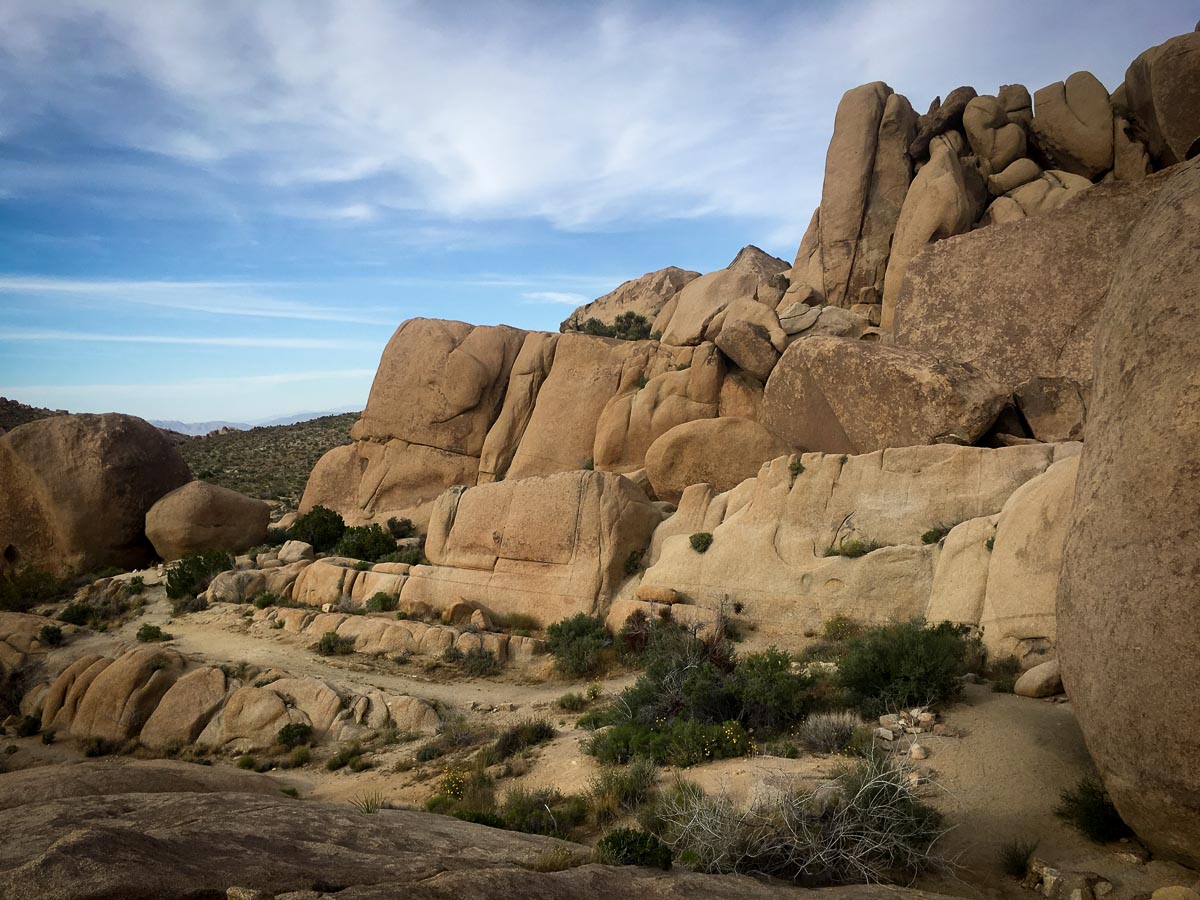
“You talked a little bit about time at Cervelo and 3T. What are the lessons you’ve learned from Cervelo, from 3T, from BMC, from Scott that have become a part of the fabric of OPEN?”
“None.” Said Andy mock seriously. “We tried to make our life simpler, but we totally failed. No, I think the most important thing for both of us is we kind of learned that we are not classic managers that want to manage people and grow the business every year by 30% and end up far away from the product. I think we are both product guys [who] love what we do.“
“That’s one of the main reasons why we’re successful: we build bikes that we like ourselves. We don’t have a big marketing team that tells us what to do. We talked about freedom, freedom in production, freedom in your head, that’s something we realized; that we are doing something with zero compromises. And sometimes, as we see now, that means it’s 10 times more complex than our current lineup. And probably in every other company, people would have said, hey, this is a logistical nightmare. But we want to do it because we believe in it. So I think freedom is probably the most important thing.”
Andy continued, “When we started OPEN, we basically had a couple of core principles and one was, not really sponsoring anybody, and that’s not because we don’t want to spend the money… like you right? This is probably the first bike that you’ve actually bought for a long time, and that gives the product credibility. It’s basically the best marketing tool you can have.”
Every rave review is authentic. I see the strategy, of course, but it doesn’t prevent me from saying, “I’m quite happy for you to change your position here, if you want to start sponsoring just one British cycling journalist in the UK.”
“I’m sorry, even Lenny Kravitz had to buy his bike,” replies Andy.
Ah well. Worth a try.
It’s resulted in something I’ve certainly noticed around the industry. It’s like OPEN is a cycling industry secret that no one’s trying to keep. So many industry people I talk to have an OPEN bike, and the incidence of them amongst cycling ‘professionals’ is dramatically higher than as a percentage of bikes ‘in the wild.’ It led me to a conclusion and a tag line I offered Andy and Gerard, ‘those who know, ride OPEN.’
They didn’t seem desperate to use it, but perhaps they’ll come around.
Custom Building My Own OPEN U.P.PER CONCE.PT

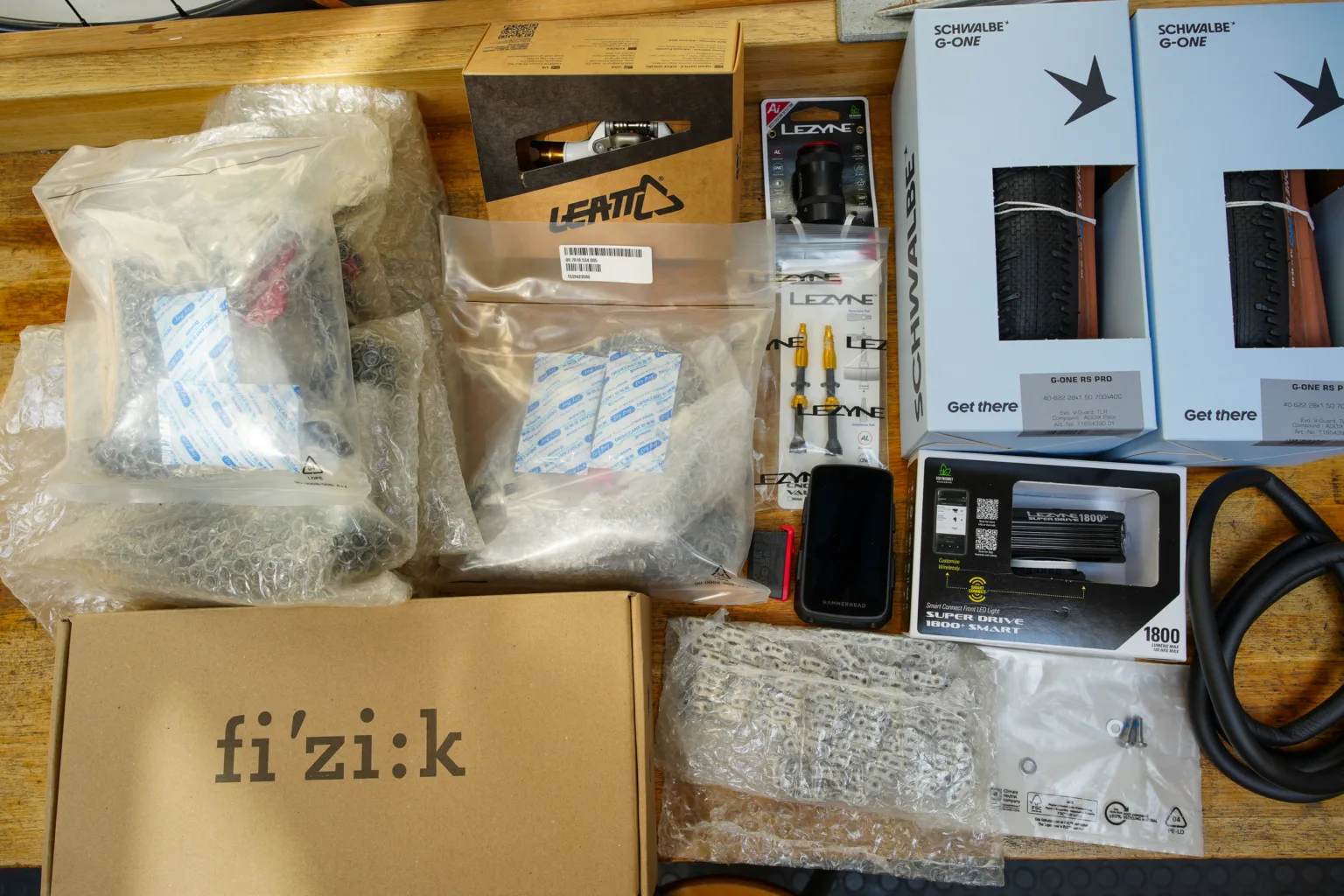
In the intervening weeks since interviewing these two legends, I’ve reflected on what they’ve said… and on various events have shaped the cycling industry more than anyone could have foreseen. This piece began as an exploration of the ‘bravery’ (I guess), to buck the trend of Asian fabrication, and increase their own costs by bringing production to Europe, for twice or even three times the price. With US tariffs meant to severely penalize Chinese imports, Specialized and Trek have road-mapped price hikes for the US market, passing the buck to the end consumer. Perhaps OPEN’s EU build, avoiding those tariffs, will, quite ironically, make their new bikes more affordable to an American consumer than offerings fabricated in China. I would say that was great Karma for OPEN.
OPEN U.P.PER CONCE.PT – Actual Weight

Right now, their Concept bike has a few remaining examples left from the 125 made, in size M & size L.
I’ve apparently got frame number 2 out the door. I hadn’t ridden it when I interviewed Andy and Gerard, but I have now (just a little). It was custom-painted by Tom Hunt at Kustomflow, and built by Cyclefit in London.
The ready-to-paint frame was 833 grams (quoted 845) for a size M. It is now 865 grams painted, and has built up to be an incredible 7.3kg with pedals and computer mount.
Like OPEN, I wasn’t trying to make it lightweight, particularly, but it has happened.
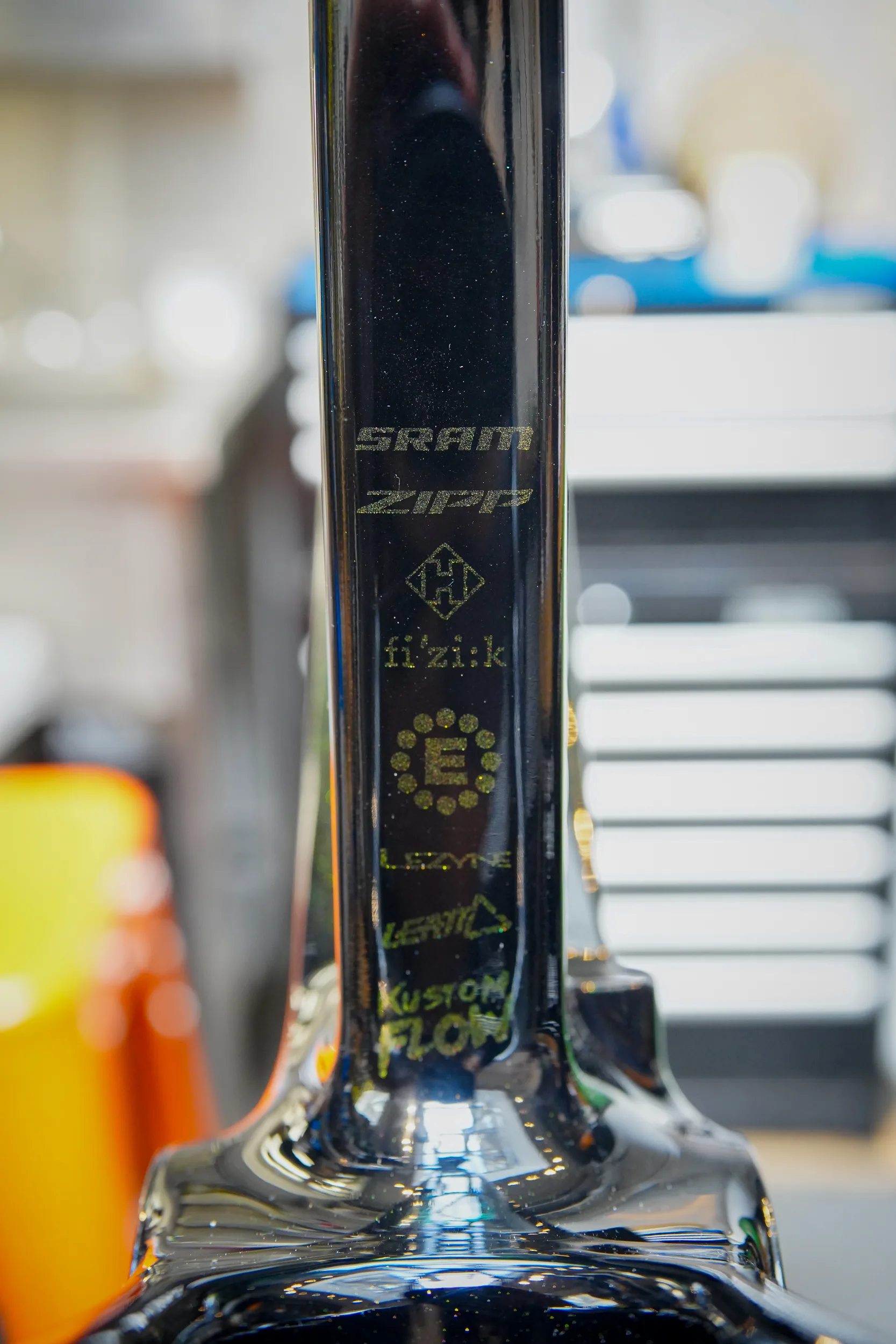
Also, the new Leatt ceramic titanium pedals are lighter than XTR at 299g a pair, and the Fizik 3D-printed saddle, though comfy, is 210 grams.
A manufacturer would certainly quote complete bike weight without pedals and computer mount, which would put this fractionally sub 7kg (15.43lb). For a gravel bike… with 40mm tires.
Enduro’s XD15 ceramic BB saves some weight. But I chose it because of its lifetime warranty, and the greatest line I’ve come across for a while: it has “no servicing requirements”, EVER! Zipp’s 353NSW wheels are for sure both a compliant and feathery luxury, and the Schwalbe G-One RS Pros are about as supple and lightweight as 40mm tires get.
First Riding Impressions
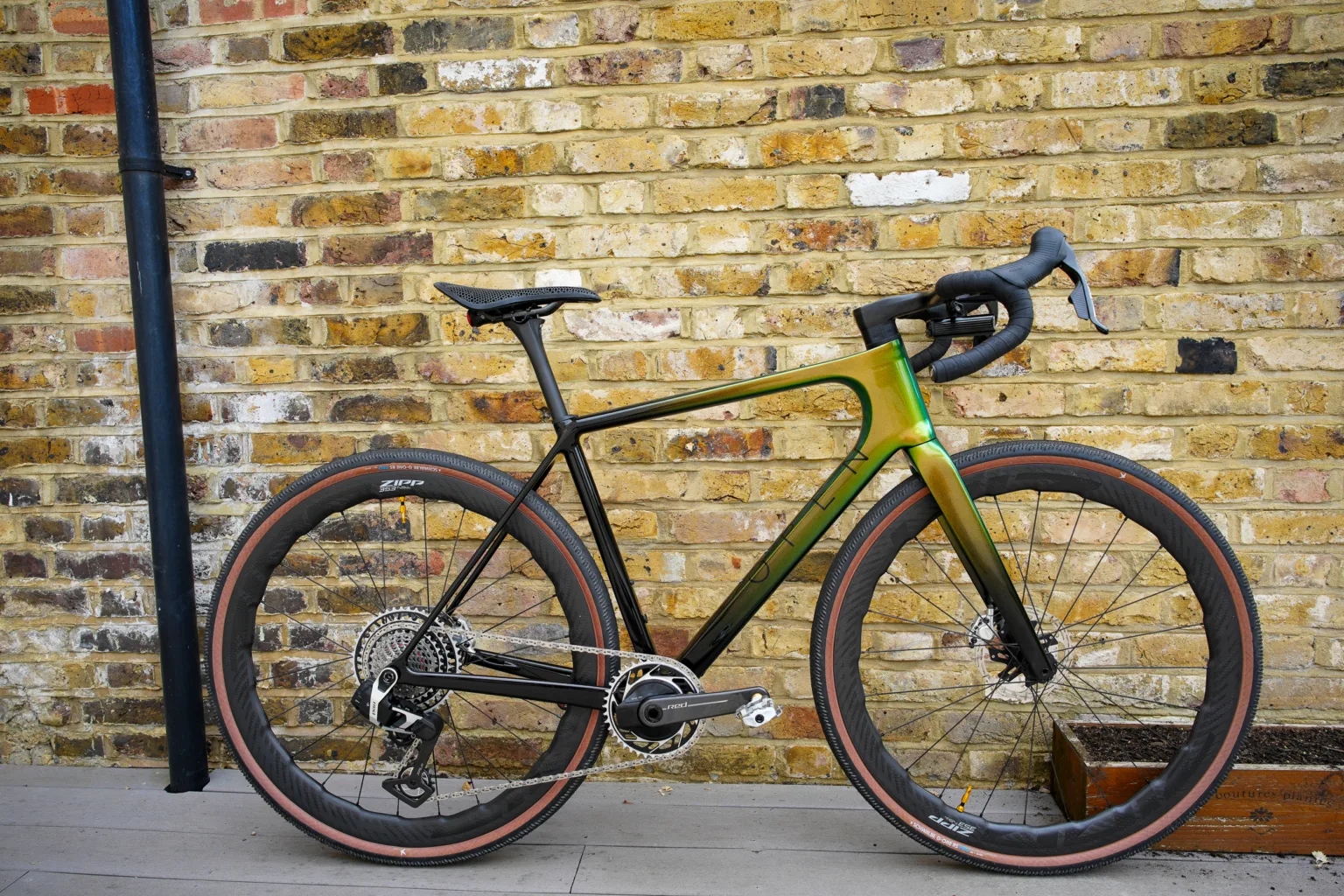
Andy was right; despite riding and writing about a great many bikes, this is the first bike I’ve bought myself in nearly 7 years. And I’m possibly suffering from confirmation bias, but it’s an astonishingly good bike. This bike is the most comfortable unsuspended bike I’ve ever ridden, let’s start there.
It’s lively, exciting, and direct. It’s snappy to accelerate, plenty stiff at the bottom bracket, and accumulates speed readily. I’ve ridden some great offerings from big brands (that I really fell for at the time) whose specs square up with the OPEN on paper, and they’re all within fractions of each other in terms of direct, playfulness, engaging ride, etc.
The OPEN has them all beat in one aspect, however. It’s so damn comfortable. Nothing else I’ve ridden feels like an OPEN. And it does it without sacrificing any of the stuff you want out of a performance bike. It’s a racecar that feels like an SUV, an 865g carbon racer that thinks it’s a cruiser.
Within the first 200 meters, I knew that my titanium bike would probably never get ridden again and was now heading for the second-hand market. I’ve had a soft spot for a while, for the abject stiffness of an S-Works Tarmac SL8, but at any distance over about 100m I’d take the OPEN. SRAM’s Red XPLR is for me, without meaningful challenge as a quality of life/performance offering, and its flawless integration with the Hammerhead Karoo is peerless.
It’s also my first time jumping with both feet into Silca’s full-on hot wax system, and I’m a convert.
What’s the Future of Open?

OPEN’s fork/cockpit integration is great, and I hope it finds a life and use beyond OPEN. I can see people getting value out of being able to change their bike’s reach as fitness, flexibility, preferences, courses, and even multiple users, change. Also, I was going to paint the bars to match the frame, when Tom the painter advised me not to. “Don’t do it,” he said. “The bars look mint.” …and they do.
“So what’s the future for OPEN?” I say to the pair as a final question.
“What do I always say? I forgot,” starts Andy. “We make a step U.P. now. The future is WI.DE. OPEN. The only risk is that we lose our MIN.D.”
